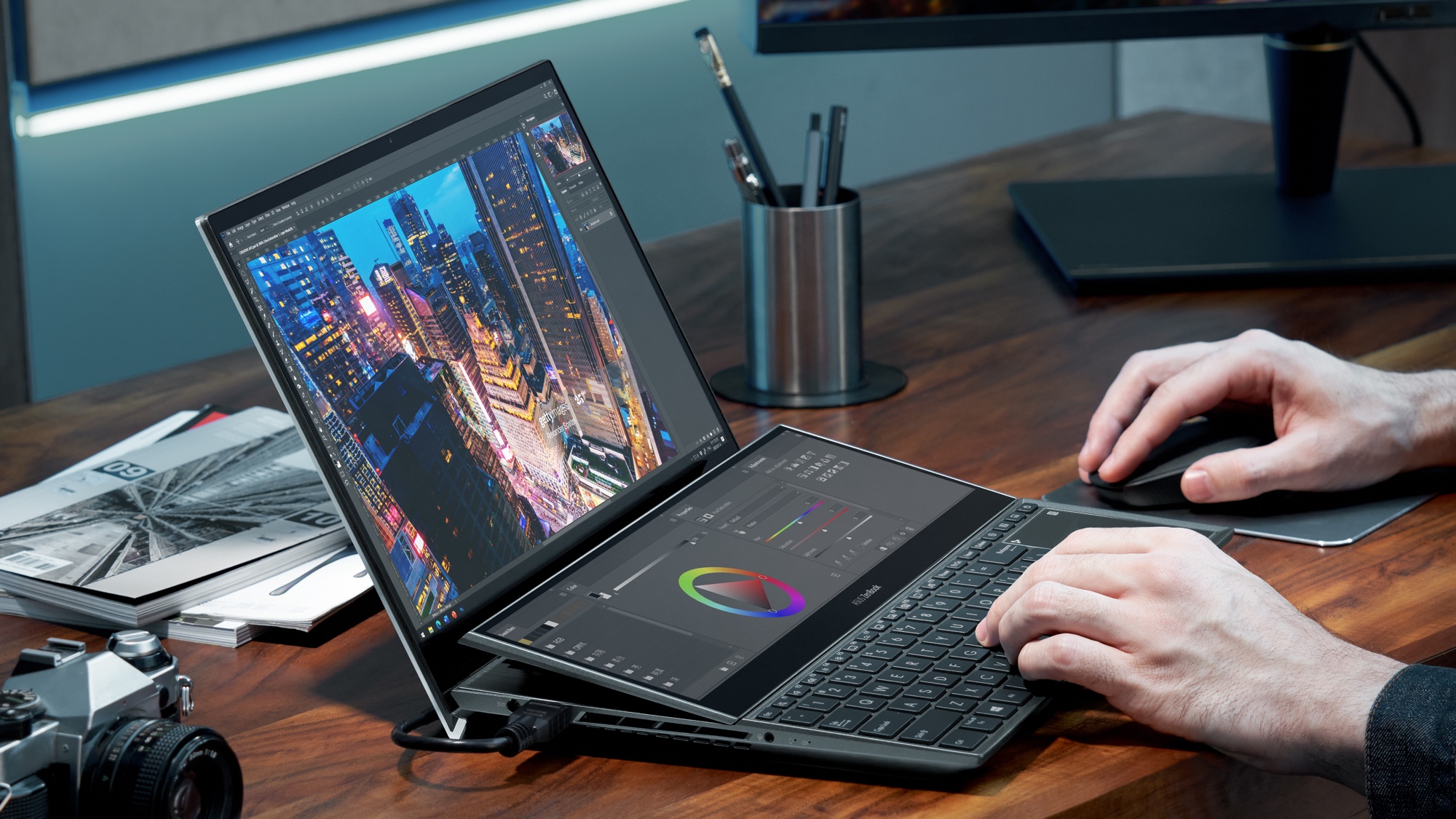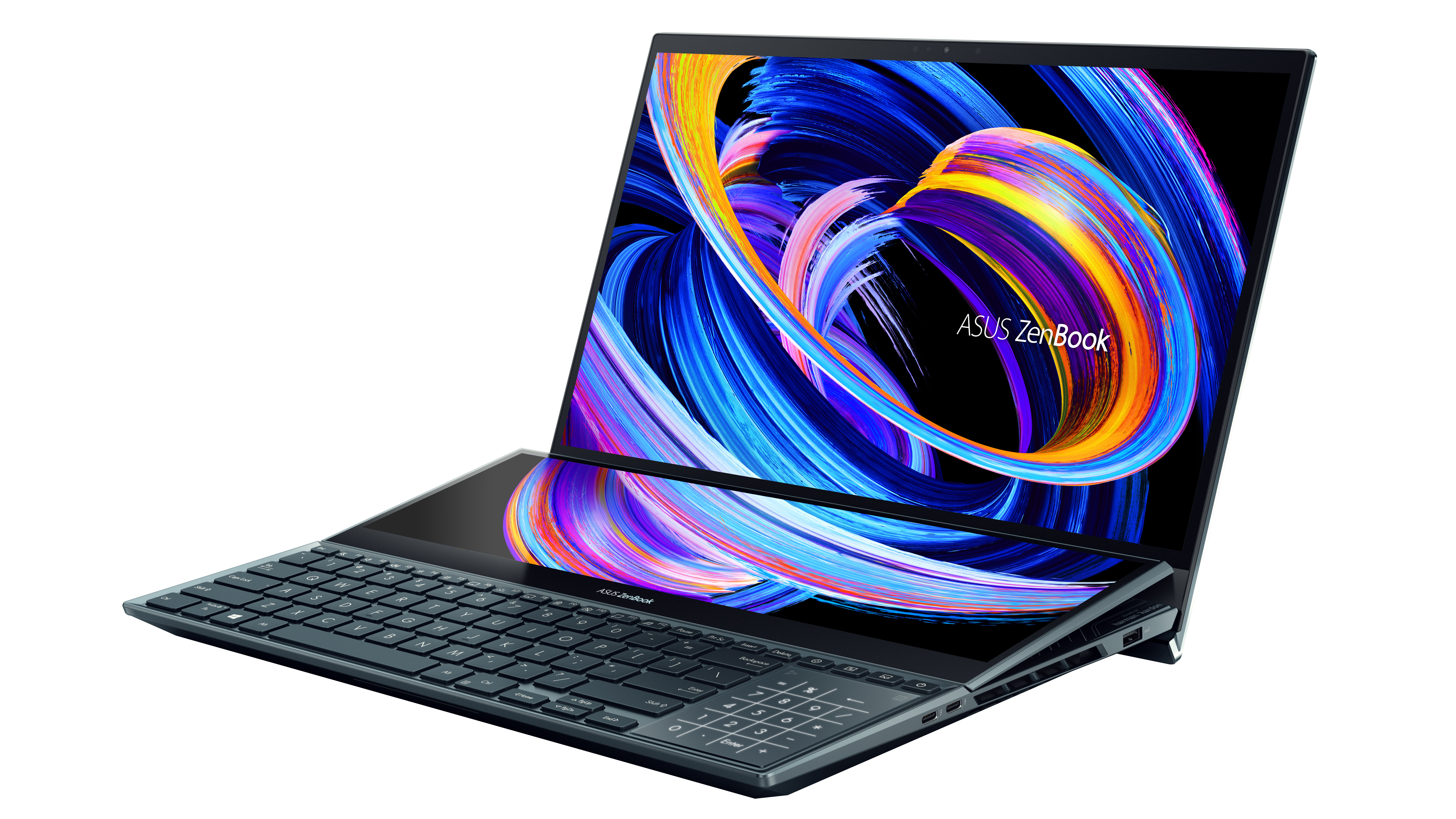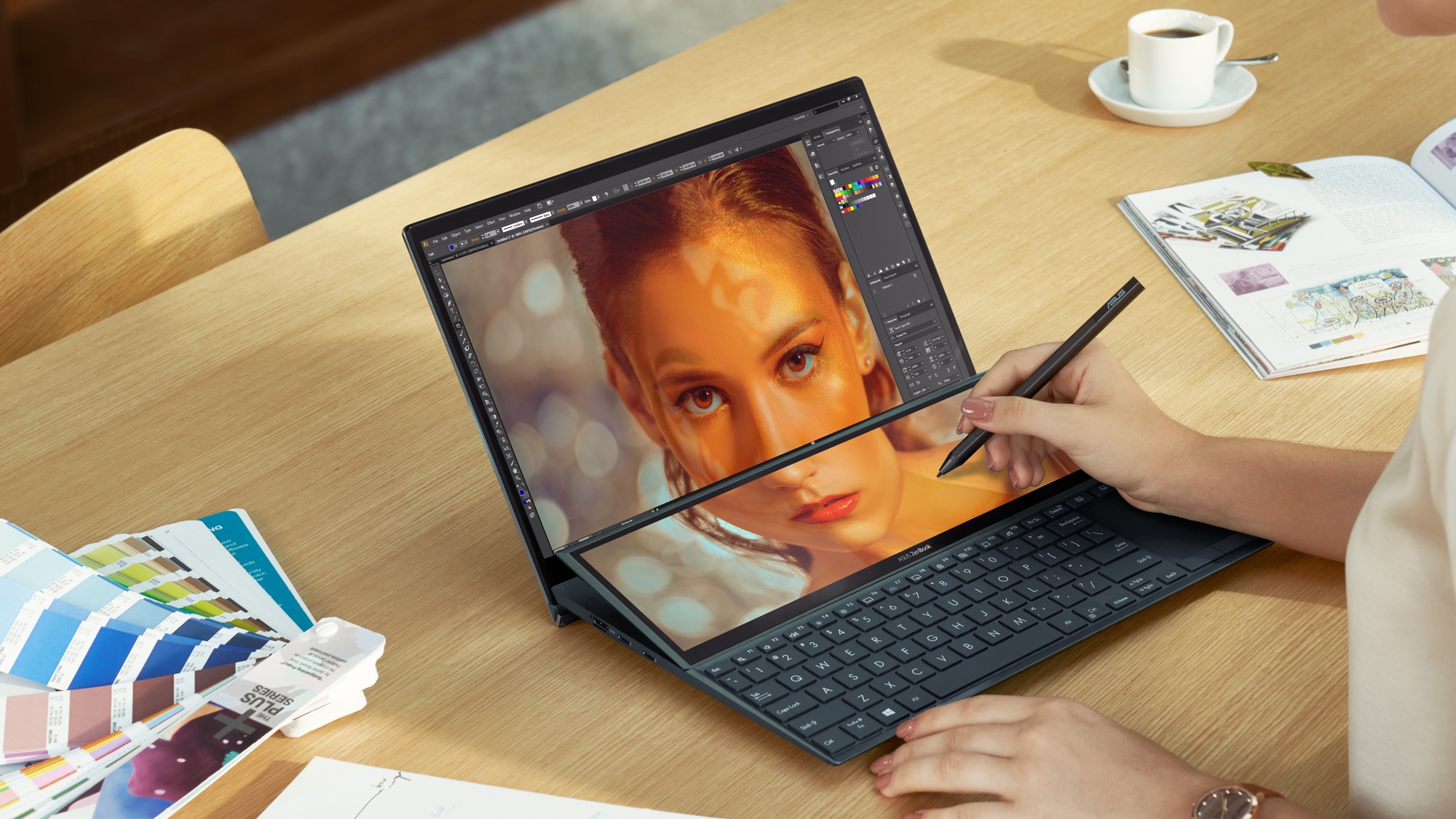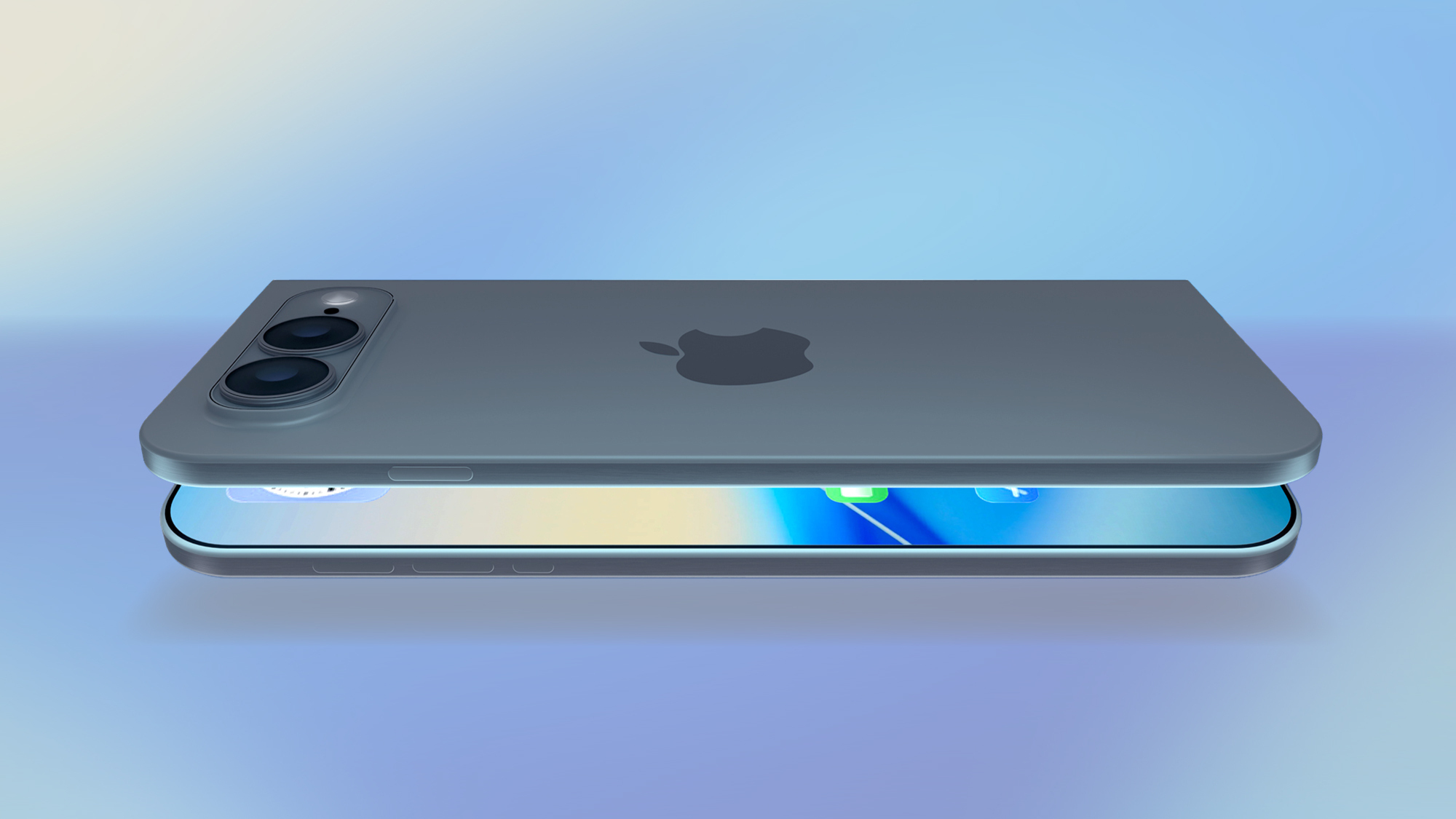Forget MacBook Pro: Asus ZenBook Pro Duo 15 makes the Touch Bar look dumb
The ZenBook Pro Duo 15 OLED makes us want to believe in its smaller big screen

The ZenBook Pro Duo 15 OLED takes Asus' wild ScreenPad Plus, a massive secondary display that sits above the keyboard and tilts it up 9.5 degrees this year. And from looking at the latest photos from CES 2021, the tilt feature is something Asus should have done from the beginning.
Previous ZenBook Duo laptops had this large screen lying flat to the deck, and looking at the new model, I can't imagine it any other way. Plus, Asus is increasing the brightness of the ScreenPad Plus to 400 nits, increasing its visibility.
While the dual-screen design of the ZenBook Pro Duo 15 may look like a gimmick or novelty, the kind of thing that companies trot out for headlines — this is CES 2021 after all — Asus notes that 1 in 5 ZenBooks sold in 2020 was a Duo.
- The best laptops, ranked
- Here are some of the best cheap laptop deals
- Plus: Samsung One UI 3 arrives: These are the top features
Asus' new ScreenPad Plus panels come with more tricks, too. It's built around the Screen Xpert 2 tools, which introduce a new feature called Window Flick. As you may have guessed, this trick simplifies sending windows from the main screen to the ScreenPad Plus, with the flick of a finger. Asus updated the Task Group app, adding the ability to create groups of organized-by-screen apps you can open in a single click.
A new ScreenPad Plus Control Panel is also added in ScreenXpert 2 (and coming to older Asus Duo laptops, which will make it easier to customize the second screen. Creative apps are also getting touch-sensitive tools for just this window, and it sounds like a better version of the Touch Bar on MacBooks. Current compatible apps include major Adobe programs including Photoshop, Lightroom Classic, Premiere and After Effects. Asus is looking to build more apps in, in the future.
Processors: Intel Core i7-10870H, i9-10980HK
Graphics: Intel UHD Graphics and Nvidia GeForce RTX 3070 laptop GPU w/ 8 GB GDDR6 memory
Memory: Up to 32GB
Storage: Up to 1TB SSD
Weight: 5.3 pounds
Dimensions: 14.1 x 9.8 x 0.8 inches
Asus ZenBook Pro Duo 15 OLED price and availability
While Asus notes the ZenBook Pro Duo 15 OLED is coming to North America in April 2021, it has not yet revealed pricing. We look forward to updating this page with that detail once we learn more.
Asus ZenBook Pro Duo 15 OLED (UX582) design
The centerpiece — literally and figuratively — of the ZenBook Pro Duo 15 OLED is its 14-inch 4K ScreenPad Plus display, which emits up to 400 nits of brightness. Asus' ErgoLift hinge mechanism rotates the panel up and to meet the display, giving massive benefits.
Get instant access to breaking news, the hottest reviews, great deals and helpful tips.
For starters, the screen is just plain easier to see — or at least that's how it looks, we're sadly not there in person for CES 2021 — since it's not hiding behind the keyboard anymore. Plus, the laptop's cooling system is uses the gap created by the now-tilted ScreenPad Plus to increase overall cooling airflow by 36%.

Also, there's decent connectivity, with dual Thunderbolt 3 USB-C ports (up to 40GBps, supporting Power Delivery and DisplayPort), a USB-A port, HDMI 2.1 and a headphone jack. HD displays.
Asus ZenBook Pro Duo 15 OLED (UX582) display
Oh, and while the ScreenPad Plus is a marquee feature, the true star of the ZenBook Pro Duo 15 OLED (UX582) is its 4K OLED HDR touchscreen. Asus is trying to make the bezel extinct with this design, which gives you a 93% screen-to-body ratio. The panel's OLED technology features the strong colors, deep blacks and 1,000,000:1 contrast ratio you should expect from OLED, and Asus had it certified by with VESA DisplayHDR True Black 500 certification.
For color quality assurance, there's also PANTONE Validated certification, and Asus rates it as covering 100% of the DCI-P3 spectrum. And for eye-care there's the increasingly ubiquitous standard of TÜV Rheinland certification, which translates to low blue-light levels, for those worried about prolonged exposure to that spectrum.

Asus ZenBook Pro Duo 15 OLED (UX582) performance
The ZenBook Pro Duo 15 OLED has a new NVIDIA GeForce RTX 3070 laptop GPU and runs on an 8-core Comet Lake 10th Gen Intel i9-10980HK processor. You'll be able to buy it with up to 32GB of RAM and 1TB of PCIe storage.
This is one of the first Nvidia Studio laptops to sport NVIDIA GeForce RTX 30 Series laptop GPUs, specifically the GeForce RTX 3070. And that means you get the second-generation RTX architecture for GPU-accelerated ray tracing, artificial intelligence, and video encoding.
Asus ZenBook Duo 14 (UX482)
There's also the new ZenBook Duo 14, which — as you may have guessed — has a 14-inch screen. This panel is also PANTONE validated, but it's a 1080p anti-glare panel. Its ScreenPad measures 12.6 inches and tilts up 7 degrees.
This model has 11th Gen Intel Core i5 and i7 processors, Nvidia GeForce MX450 graphics with 2GB of dedicated memory, up to 1TB of SSD storage and up to 32GB of RAM.

As with the Pro Duo 15 OLED, we don't know the pricing yet, but this model will go on pre-order later this month (Jan. 2021) in North America. But unlike its 15-inch big brother, we do have battery life numbers for the ZenBook Duo 14: Asus estimates it to last 17 hours on a single charge, based on MobileMark 2018. We look forward to running it through our web surfing based battery test.
Asus ZenBook Pro Duo 15 OLED outlook
We're eager to get a ZenBook Pro Duo in our hands for review, to see if its big secondary screen is worth all the space it takes up on the keyboard. This unique design forces your palms to rest in front of the keyboard, as you've got no wrist rests on the deck. But hopefully, Asus' decision to lift and brighten the panel makes it a valuable asset. Stay tuned for our full review.

Henry was a managing editor at Tom’s Guide covering streaming media, laptops and all things Apple, reviewing devices and services for the past seven years. Prior to joining Tom's Guide, he reviewed software and hardware for TechRadar Pro, and interviewed artists for Patek Philippe International Magazine. He's also covered the wild world of professional wrestling for Cageside Seats, interviewing athletes and other industry veterans.
